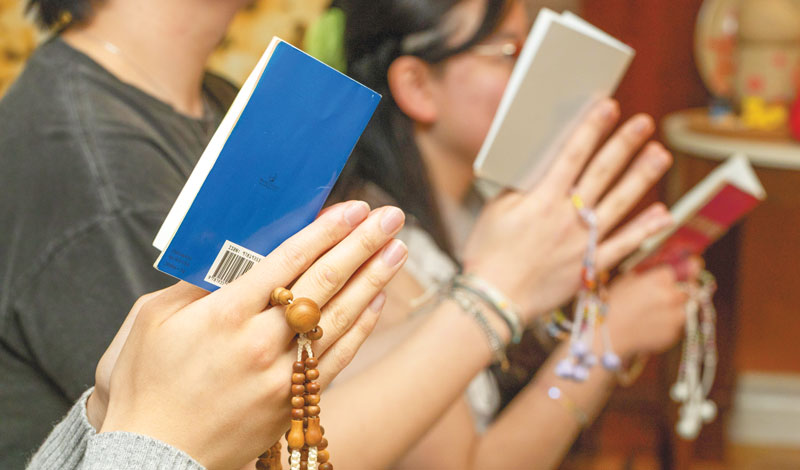This new study series will cover Soka Spirit topics to be presented by a youth or student division member at Soka 2030 meetings on the last Sunday of each month.
If there exists a votary of the Lotus Sutra, then the three types of enemies are bound to exist as well. (“The Opening of the Eyes,” The Writings of Nichiren Daishonin, vol. 1, p. 278)
Nichiren Daishonin clarifies that obstacles will come our way when we propagate the Lotus Sutra and strive for people’s happiness. According to the Lotus Sutra, the “three powerful enemies” are the most formidable obstacles.[1]
Understanding them is key to staying resolute on the path of spreading Buddhism. Let’s break them down:
1) Arrogant lay people are ignorant of Buddhism but go out of their way to verbally or physically attack Buddhist practitioners.
2) Arrogant priests think they are enlightened but are really just focused on their own egos, perverse wisdom and preconceived beliefs.
3) Arrogant false sages are the trickiest and most dangerous of the three enemies. They act wise and virtuous, but deep down, they’re fueled by greed, jealousy and malice, seeking profit and power.
Though described in the centuries-old Lotus Sutra, we can still see the same powerful enemies in modern form.
One clear example?
The Nichiren Shoshu priesthood—especially Nikken Abe, the high priest who led the excommunication of the Soka Gakkai in November 1991. He acted not to protect the sanctity of life or faith in Nichiren Buddhism but to exert authority over sincere practitioners. Nichiren warned of such arrogant false sages.
Priests’ Wartime Betrayal: Turning Away From Nichiren’s Noble Spirit
In July 1943, Japan’s military government arrested Josei Toda for refusing to recant his belief in Nichiren Buddhism and accept Shinto, the state religion. His mentor, founding Soka Gakkai President Tsunesaburo Makiguchi, was also arrested and later died in prison, never compromising his beliefs.
Meanwhile, how did Nichiren Shoshu respond to the military regime’s intensifying pressures on religious organizations to support Shintoism? They caved to that pressure in various ways, going so far as to delete and ban the usage of more than 200 phrases and passages from Nichiren’s writings deemed disrespectful toward the emperor or Shinto deity. They also rewrote their silent prayers in gongyo to praise state Shinto and the wartime government.[2]
This clearly goes against Nichiren’s teaching.
The Soka Gakkai Helps the Priesthood Overcome Financial Struggles
After the war, the priesthood fell into poverty. Their head temple, Taiseki-ji, had burned down, branch temples had been destroyed by air raids, and their landholdings—once a significant source of income—had been seized due to agricultural land reforms.
Desperate to generate income, the priests decided in November 1950 to turn Taiseki-ji into a tourist attraction.
Mr. Toda, who had been released in July 1945, was appalled. The head temple was no place for tourists without faith in Nichiren Buddhism, and profiting from them would dishonor Nichiren’s noble spirit.
Despite the priesthood’s behavior during the war, he found a way to help them become financially stable.
He proposed that the Soka Gakkai lead group pilgrimages to the head temple. These began two years later in 1952, and, over the years, Soka Gakkai members went to great lengths to restore and improve the temple grounds, making countless donations of money and land to help the temple flourish. Over four decades, they made more than 70 million pilgrimages, and the Soka Gakkai donated land to the head temple, assisting the priesthood in expanding their landholdings 23 times its original size.
How did the priests repay them? In July 1991, they abruptly announced a new pilgrimage system that required people to register as parishioners of local Nichiren Shoshu temples to enter the head temple grounds, essentially banning Soka Gakkai members and trying to coerce them into joining the temple.[3]
No Obstacle Can Stop Us
In his writings, Nichiren consistently reminds us that we are bound to face resistance whenever we stand up to spread the Mystic Law. But no matter how powerful our enemies are, true power lies in sincere, dedicated practitioners uniting based on a vow to spread Nichiren Buddhism and establish a society of respect for the dignity of all people.
The Soka Gakkai continues to grow and flourish around the world, staying focused on working for the happiness of all people and realizing Nichiren’s goal of kosen-rufu. No obstacle or powerful enemy can stop our Soka movement built on sincerity, courage and an unshakable vow for kosen-rufu.
You are reading {{ meterCount }} of {{ meterMax }} free premium articles

